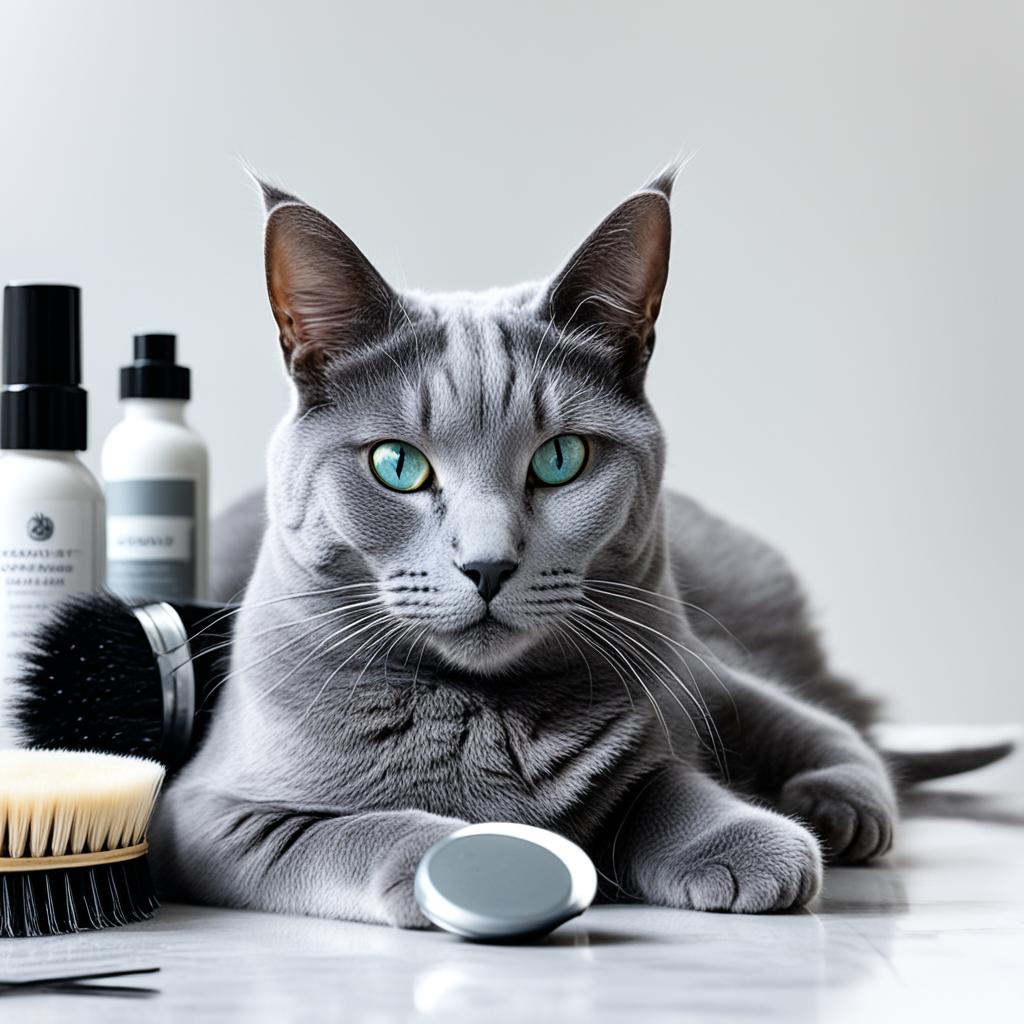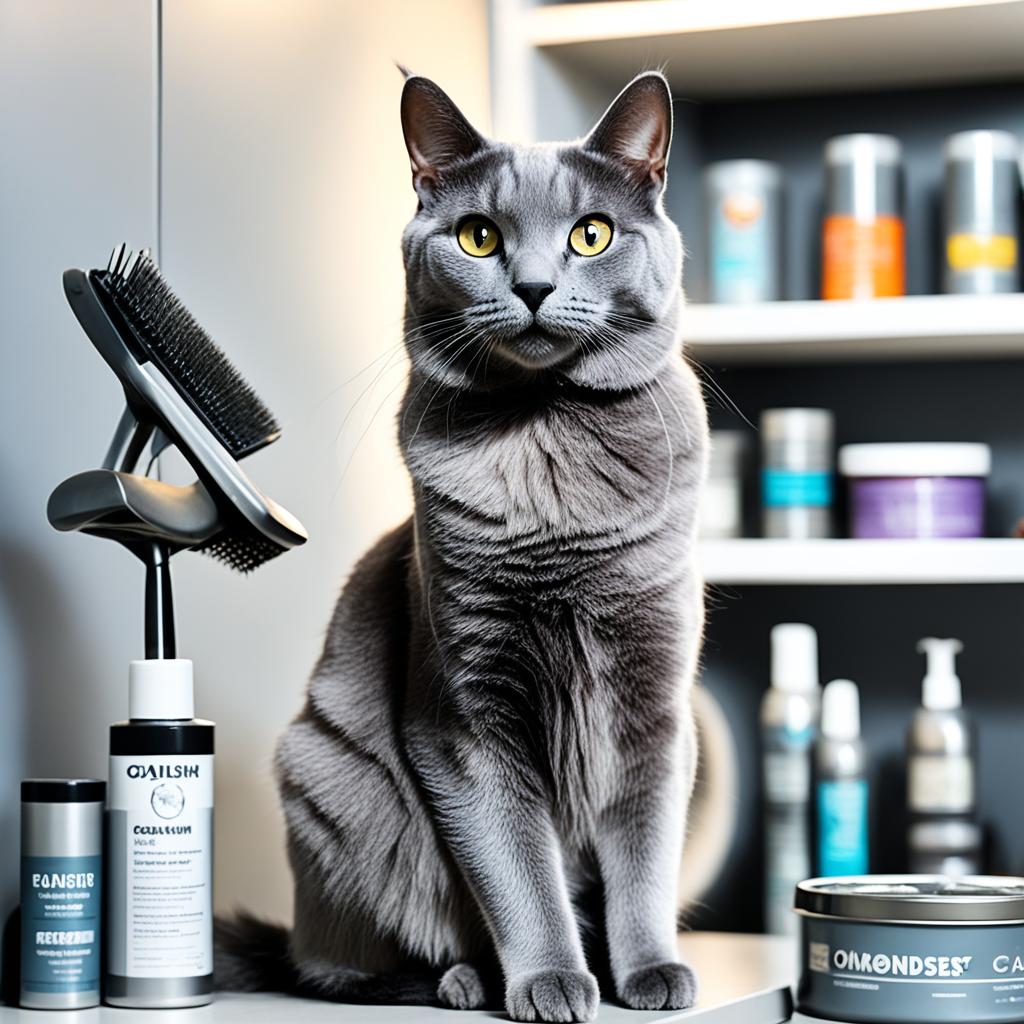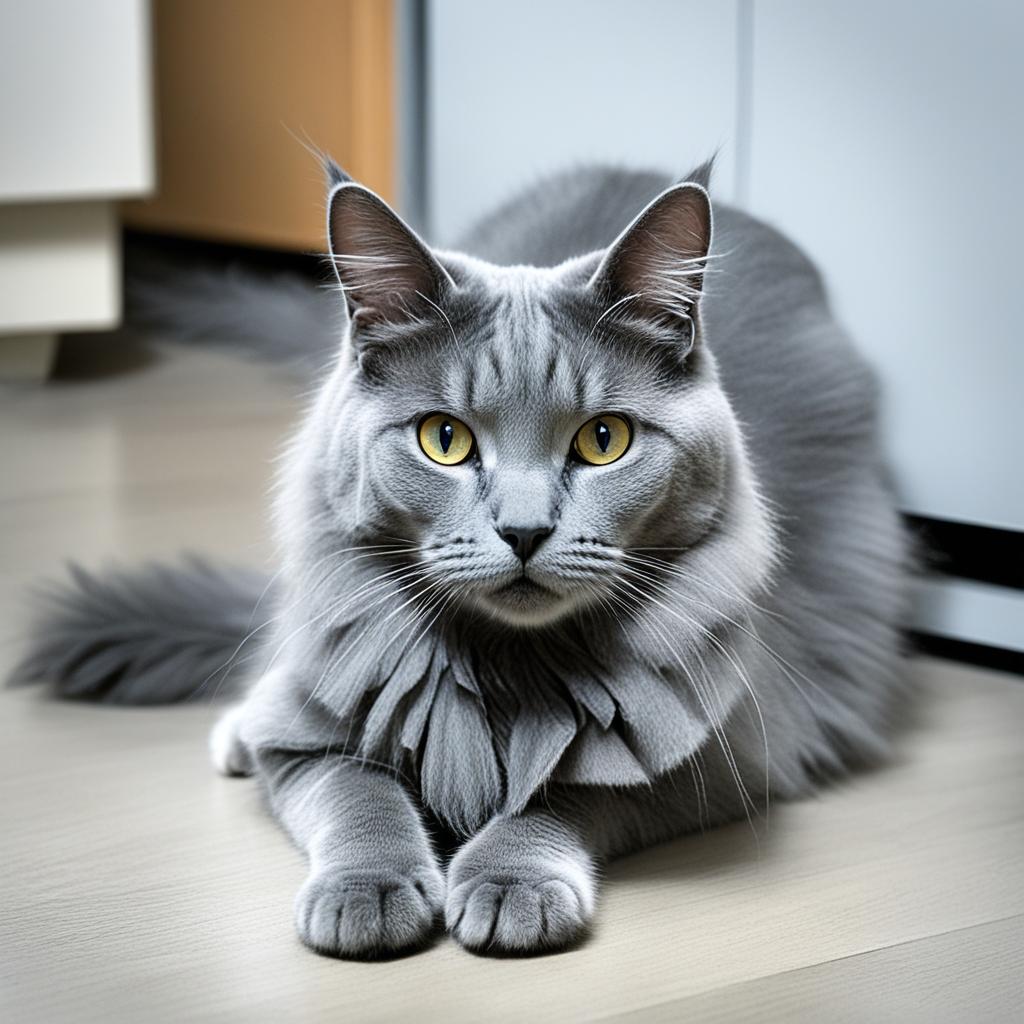Do you ever think about why Russian Blue Cats cough up more hairballs? It’s true, dealing with hairballs is a big issue for them. To keep your Russian Blue Cat happy and healthy, it’s important to know why they get hairballs and how to stop them. Good grooming habits are a big part of this because they reduce shedding, which causes hairballs.
Key Takeaways
- Hairballs are common in Russian Blue Cats due to their plush coats.
- Regular grooming can significantly reduce hairball formation.
- Understanding the shedding process helps in better hairball management.
- Using the right tools and techniques is essential for effective grooming.
- Overall cat care, including diet and stress management, is crucial in preventing hairballs.
Understanding Hairballs in Russian Blue Cats

Russian Blue Cats are famous for their soft, silky fur. But, this beauty can lead to hairballs. It’s important to know why these cats get hairballs to take good care of them.
The Natural Shedding Process
All cats shed to replace their old fur with new. Yet, Russian Blue Cats have a special double coat that sheds a lot. Things like stress, diet, and their surroundings can make this shedding worse.
Why Russian Blues Are Prone to Hairballs
Because of their thick coats, Russian Blues often develop hairballs. When not handled well, these cats can swallow more fur while grooming. Learning how to deal with hairballs can greatly help keep your cat happy and healthy.
| Key Factor | Impact | Solution |
|---|---|---|
| Stress | Increases shedding | Provide a calm environment |
| Diet | Affects coat health | Balanced nutrition |
| Boredom | Leads to over-grooming | Interactive toys and playtime |
Effective Grooming Tips for Hairball Prevention

Grooming regularly is key to keeping hairballs at bay. Use the right brush and tools for your Russian Blue cat. This method will cut down on hairballs and improve your cat’s well-being.
Regular Brushing Techniques
Make brushing a habit to prevent hairballs. Aim for two to three times a week with gentle strokes. This way, you catch loose fur before it’s a problem. Your cat will like being groomed too.
Best Brushes for Russian Blue Cats
Choosing the right brush matters for Russian Blue cats. Go for a slicker brush or a grooming mitt. These tools get deep into the thick coat but are soft on your cat’s skin. With the proper tools and technique, grooming your cat can be simple and easy.
Grooming is also a great way to bond with your cat. It keeps them happy and healthy, too.
How to Prevent Hairballs in Russian Blue Cats?

Dealing with hairballs in your Russian Blue cat takes a few steps. These tips for managing hairballs cover grooming, diet, and overall cat health. They will help your cat live its best life, without the hairballs.
First, make sure to groom your cat regularly. This can be a big step in fighting off hairballs. Choose a brush that’s good for the thick, soft fur of Russian Blues. This will reduce how much your cat sheds, making it easier on your cleaning.
Next, pay attention to what your cat eats. A well-balanced diet is key, especially food that fights against hairballs. Look for cat food made to stop hairballs, as these often have special fibers. Adding omega-3 fatty acids to their diet can also help. It makes their coat healthy and reduces shedding.
Also, it’s important to keep your cat moving. Exercise keeps your cat in good shape and helps lower stress. Stress can make hairball problems worse. Lots of toys and fun activities can make your cat’s day and keep them healthy.
- Groom regularly with appropriate brushes.
- Introduce fiber-rich, hairball-preventive cat food.
- Maintain consistent exercise routines to reduce stress-induced grooming.
Adding these Russian Blue cat care steps to your routine can make a big difference. by following these tips, you can have a happy, hairball-free feline friend. Enjoy the peace and joy of a cat who’s feeling great.
Dietary Recommendations for Reducing Hairballs

If you want to prevent hairballs, good food is key. This is especially true for Russian Blue Cats. A balanced diet is fundamental for lessening hairballs and keeping your cat’s fur healthy.
Ingredients to Look For
Look for meals with high-quality proteins and omega fatty acids for your Russian Blue Cats. These nutrients are crucial for a shiny coat. They also help prevent hairballs.
Essential nutrients are just as important. They keep your cat healthy overall.
- High-quality proteins: Essential for strong fur.
- Omega fatty acids: Enhances skin and coat health.
- Essential nutrients: Support overall well-being.
Importance of Fiber in Diet
Fiber is essential for stopping hairballs. It helps the cat’s body move hair through the system. This lowers the chance of hairballs.
| Nutrient | Function | Sources |
|---|---|---|
| Fiber | Aids digestion | Pumpkin, vegetables |
| Omega Fatty Acids | Maintains coat health | Fish oil, flaxseeds |
| High-quality Proteins | Builds strong fur | Chicken, fish |
Following these food tips will keep your Russian Blue Cats’ coat smooth and hairballs at bay.
Managing Stress and Boredom

Keeping your Russian Blue cat happy means dealing with their stress and boredom. Stress can cause them to groom too much, leading to more hairballs. It’s key to keep them active and entertained.
Creating an Enriching Environment
To keep Russian Blue Cats interested, you need to make their environment rich. You can do this by adding scratching posts, perches, and hiding spots. These not only encourage movement but also keep their minds sharp, which lowers stress.
Toys and Activities for Engagement
Using interactive toys and fun activities is great for giving cats something to do. Things like feather wands, laser pointers, and puzzle feeders are perfect. They keep your cat playing and busy, lessening the chances of stress shedding.
These approaches make a space that’s both calming and exciting for your Russian Blue. By doing this, you help them avoid stress, too much grooming, and hairballs.
Preventing Hairballs Naturally

Natural remedies can really help with hairball prevention in Russian Blue cats. Using a mix of diet, grooming, and natural tricks is the best way to care for your cat. A top way to stop hairballs is by choosing the right ingredients and methods.
Adding a little olive oil or butter to your cat’s meals can help. This makes their digestive system work better, which helps avoid hairballs. But, too much of these can cause problems, so talk to your vet first.
Cat grass is also a great natural remedy. It’s full of fiber, which helps move hair through your cat’s system. Adding cat grass to your cat’s space can make a big difference in their care.
Here is a quick look at how these remedies compare:
| Natural Remedy | Benefits | Usage Tips |
|---|---|---|
| Olive Oil | Lubricates the digestive tract | Use 1/4 teaspoon, mix with food, consult a vet |
| Butter | Helps with smooth hair passage | Add sparingly to meals, vet guidance is key |
| Cat Grass | Provides natural fiber | Grow in a pot, accessible to your cat |
Using these remedies and simple Russian Blue cat care steps can really help. This keeps your cat happy and can reduce hairballs a lot. Plus, your cat will be healthier overall by following these tips.
Signs Your Russian Blue Cat Might Have a Hairball Problem

Your elegant and sleek Russian Blue can sometimes get hairballs. It’s important to spot hairball signs early. This way, as a caring cat owner, you can help your cat stay healthy.
Common Symptoms to Watch For
Look for your cat making hacking or gagging sounds. This, without any hairball coming up, might mean there’s a hairball issue. Watch out for these additional signs:
- Hacking sounds that lead to no hairball production.
- Changes in bowel movements, such as constipation or diarrhea.
- Sudden lethargy or a noticeable drop in energy levels.
- A loss of appetite, which might indicate gastrointestinal discomfort.
By spotting these signs early, you can make things better for your Russian Blue. Consistent care and quick vet visits when some symptoms surface can keep your cat healthy.
Consulting Your Veterinarian

Russian Blue Cat care is important, and asking a vet is key. If your cat acts strange or seems in pain, see a vet. They can give you the best cat health advice to help, especially with problems like hairballs.
A vet can find and fix health issues early. Good Russian Blue Cat care is complex. Vets have the right tools to make sure your cat stays healthy.
Why a vet matters:
- They give expert cat health advice for your Russian Blue.
- They suggest food and vitamins changes.
- They can help solve hairball problems.
Visiting the vet often is wise, especially if your cat coughs, vomits, or acts sick. A vet can guide you to keep your kitty happy and healthy.
Conclusion
You’re on a mission to help your Russian Blue Cat beat hairballs. This journey is all about ensuring your cat is happy and cozy. Stick to regular grooming, a balanced diet, and keeping stress in check.
Grooming regularly is a great chance to bond with your cat. It’s also when you can spot any skin or coat problems early. Feed your cat plenty of fiber and nutrients to aid digestion and lower hairball risk. Plus, a fun, stress-free home helps reduce shedding.
Always chat with your vet about a personalized plan. They can recommend what’s best for your cat’s health. By following these steps to fight hairballs, your cat will be cheerful, in good shape, and free from hairball worries.
FAQ
What is the natural shedding process in Russian Blue Cats?
Why are Russian Blue Cats more prone to hairballs?
What are some effective grooming tips for hairball prevention?
What types of brushes are best for Russian Blue Cats?
How can I prevent hairballs in my Russian Blue Cat?
What dietary ingredients should I look for to reduce hairballs?
Why is fiber important in preventing hairballs?
How can managing stress and boredom reduce hairballs in Russian Blue Cats?
What are some natural ways to prevent hairballs in Russian Blue Cats?
What symptoms indicate a hairball problem in my Russian Blue Cat?
When should I consult my veterinarian about my Russian Blue Cat’s hairball issues?
Source Links
- https://swaggle.com.au/blogs/cat/how-to-reduce-cat-shedding
- https://www.quora.com/As-a-lifelong-dog-owner-I-was-utterly-shocked-to-discover-our-new-Persian-kitten-is-better-at-fetching-than-any-dog-Ive-ever-seen-hes-a-machine-and-so-Im-wondering-why-is-this-an-anomaly-something-common-to-the
- https://www.petplan.co.uk/pet-information/




